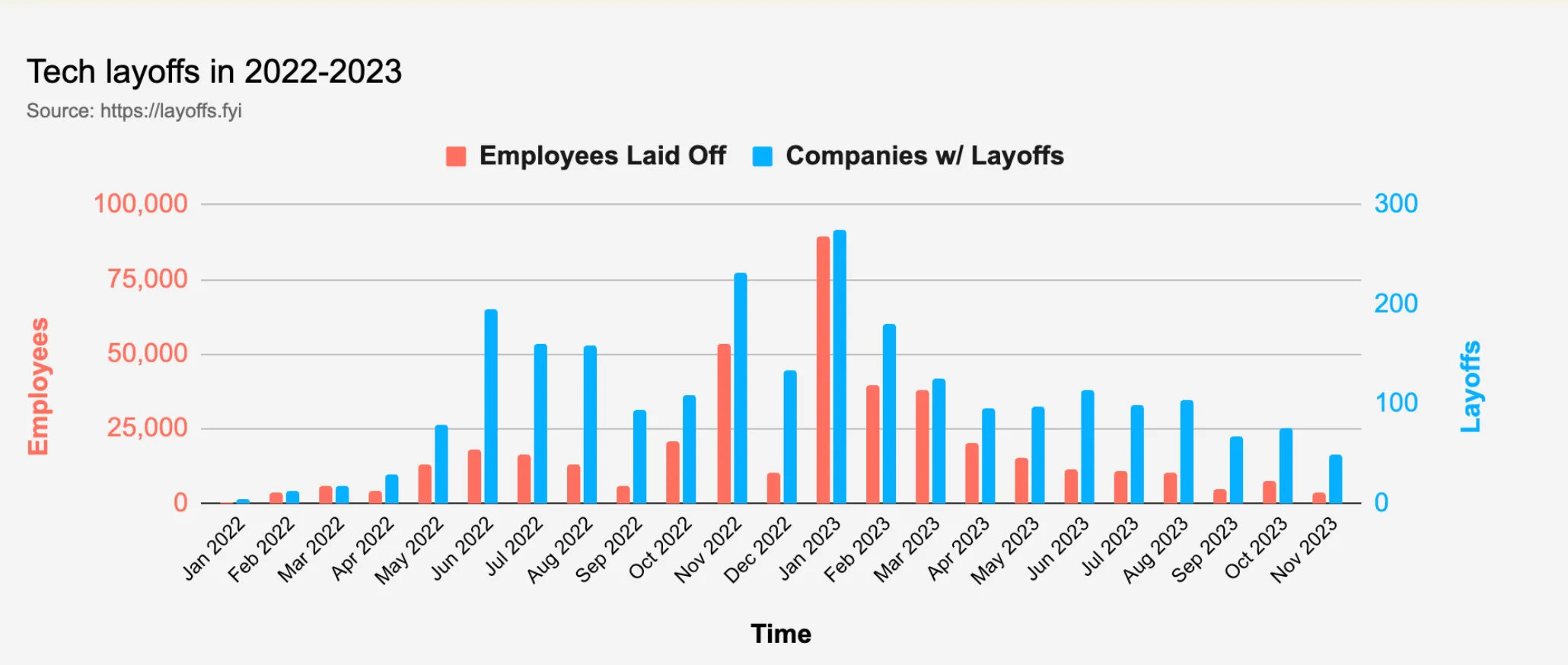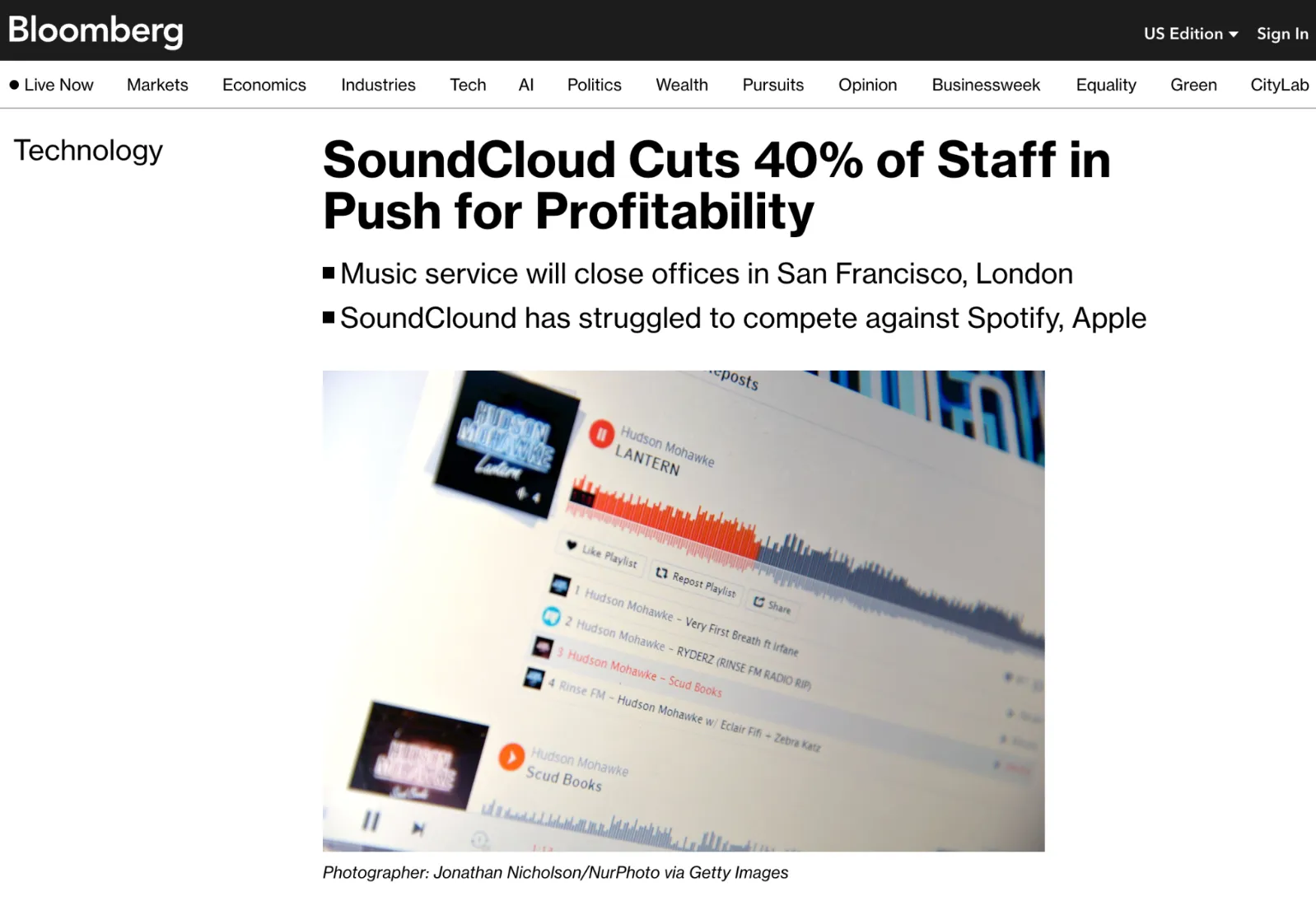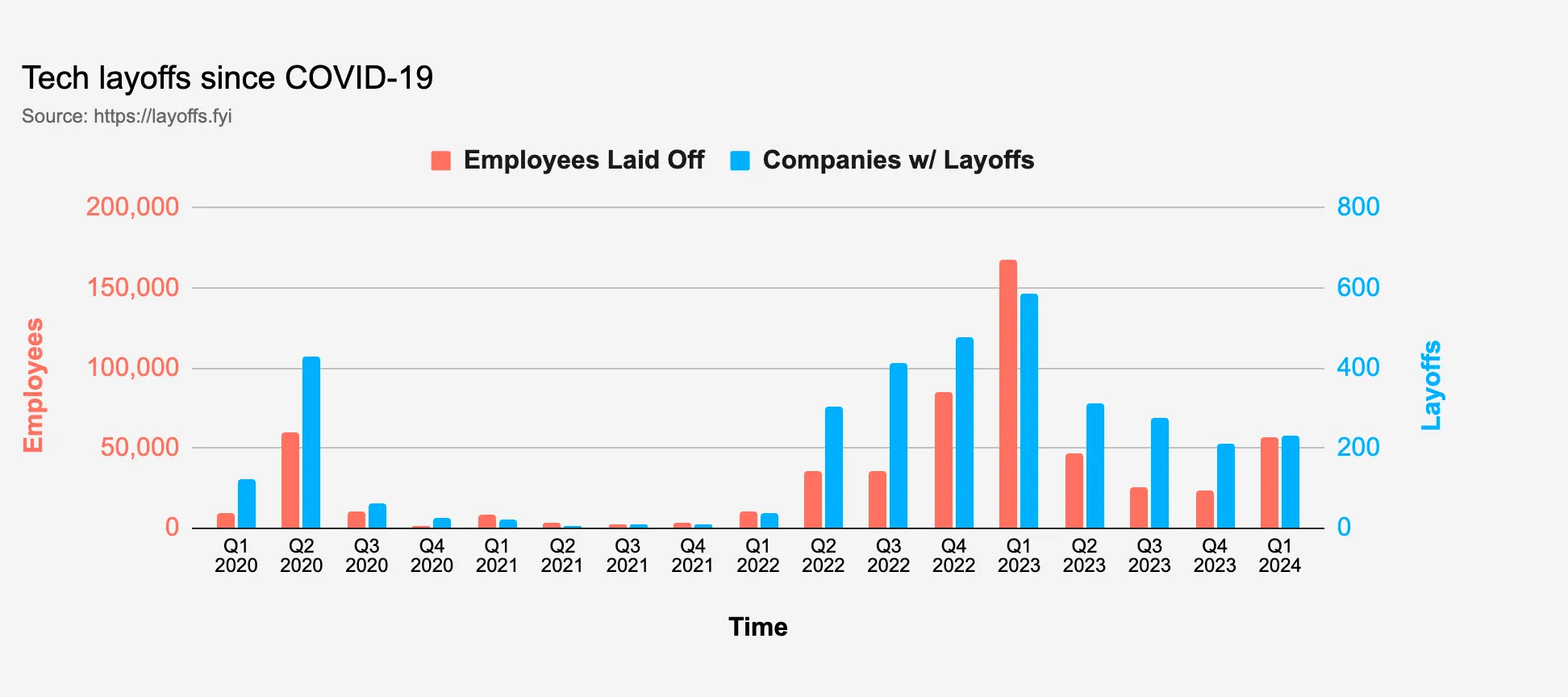· 17 min read
Building Teams in Tumultuous Times - Lessons learned after multiple layoffs
In this blogpost we delve into the challenges and resilience required in leadership during the tech industry's fluctuating landscape. This post navigates through personal layoffs experiences, offering insights into maintaining team spirit, navigating change, and learning from adversity. From Costa Rica to Berlin, it shares valuable lessons on empathy, resilience, and the continuous journey of growth amidst uncertainty.

This blogpost is based on the talk that I give at LeadDev Berlin 2023.
In our rapidly evolving tech landscape, the resilience and adaptability of leadership are more critical than ever. The past two years, marked by unprecedented job cuts across the industry, have not only tested our endurance but have also underscored the necessity of nurturing strong, cohesive teams capable of weathering any storm. In this blog post, I delve into the critical aspects of building and leading successful teams amidst adversity. Drawing from personal encounters with multiple layoffs, I try to share strategies for maintaining team morale, fostering resilience, and leveraging diversity to triumph over the challenges of change. Join me as I unfold the lessons learned from these tumultuous times.
407600
By December 2023, 407600 people have layoff during 2023, that is about 1236 people per day.

Although, the trend seems to be slowing down, I believe the skills of managing during these times are invaluable for anyone in leadership position.
Using 3 personal experiences with layoffs, we will explore strategies for keeping team spirits high, promoting resilience, and making the most of team diversity to succeed in the face of adversity and change.

My first Layoff
My first layoffs will take you back to Costa Rica, the country where I was born. In 2010, I was leading my first team - a group of highly motivated and enthusiastic engineers that we assembled to build a Voice Over IP product. My role back then was that of the Engineering Manager of the team, but I also worked as the Senior Engineer. I had to learn to juggle technical and managerial responsibilities to the best of my abilities. My days were split between hiring, defining ways of working, training, mentoring, and writing lots of code.
The company was distributed between San Diego, USA, and San Jose, Costa Rica. Most of the technical development took place in San Jose, where I led the team responsible for client and backend engineering.
As a team, we were constantly shipping, with most of our ideas being incorporated into the product. We were able to iterate quickly, learn from our mistakes, and in my opinion, we were doing great.
I vividly remember a Wednesday afternoon when we were called into a last-minute meeting. We dialed into the conference room (yes, back then we actually dialed in 📞).
The call didn’t lasted very long, but during those 10 minutes or so, we were informed that every member of the team was being laid off, effective immediately, due to internal restructure.
Feelings
One of the things that I remember the most, and probably one of the biggest learnings, is to be aware of one’s feelings and to use this opportunity to understand them better.
For me those feelings were pretty negative. I mostly had feelings of:
- Guilt. Did I failed as a manager? Is that all my doing?
- Maybe I was not good enough? I’d gotten promotions and raises throughout the years. Maybe I wasn’t good enough after all, I thought.
- Shame. I recently hired most of the people on that call. Now, what can I do to support them in finding a new job?
- Fear. What about the team? How can I support everyone during this change?
I want to be open about this, as a big organizational change like a restructure or layoffs is always going to elicit a lot of emotions from everyone involved, and it is the first thing that a manager must confront. From my own experience, I learned the following:
- It’s not about you! I was a strong performer. However, mass layoffs are business decisions and they do not reflect the worth and abilities of the individuals affected.
- Your career is bigger than a single company! If you do a good job, new opportunities and roles will come your way. People will notice, always.
- Time heals. It was a significant blow, and in the first week, I was still quite sad. But by the second and third week, I was okay, and after the first month, I didn’t really care anymore. In fact, I had already found a new job.
- Self-reflect. This period of time is valuable for self-reflection. Take a moment to evaluate your role and yourself, and gain a better understanding of your career path, strengths, and areas for growth. Personally, I used this time to focus on the technical areas that I wanted to continue learning (at that time, it was mobile engineering) and to add more structure to my learning.
Visibility
One of the key lessons I learned as a manager from this experience was the importance of creating awareness and understanding about the outcomes of your team, especially when working remotely and detached from certain business operations. In our case, the engineering efforts were taking place in Costa Rica while the rest of the business was based in the USA.
If you find yourself in a similar position, it’s crucial for you as a manager to advocate for the work your team does and create opportunities for them to showcase their achievements. This can be done through demos, all-hands meetings, get-togethers, and other means. It’s also important to establish a regular cadence, ideally every two weeks, to ensure that these opportunities are repeated consistently.
Although this was a rude awakening for any first-time manager, I managed to quickly find other opportunities and move forward. Over the next 7 years, I worked with other companies in the USA and Costa Rica.
New opportunities arose, and it was time for me to look for a new location and explore more of the world. Little did I know that those early experiences in my first role as a manager would become the foundation to what was yet to come.

My second time
I celebrated the New Year of 2016 with my family and friends in Costa Rica. Shortly after, I boarded a plane to begin a new chapter of my life in Berlin. I arrived in February, and mostly my memories of that time are filled with the cold and darkness of the February European winter, as well as the challenges of starting over. However, with 7 years of experience now, I felt confident in my ability to take on a manager role in a new environment, while also adjusting to a completely different part of the world (it was my first time in Europe), with a new language, new culture and new ways of working.
Neither the winter, the language, nor the traumatic experience of finding a flat in Berlin could diminish the excitement of starting my role at Soundcloud as an Engineering Manager. I will be working with a group of highly talented cross-platform engineers working in some very key areas.
We had a great start, and during the first 6 months, we managed to work on a variety of exciting projects.

Things were going great. The weather had improved, and I even had time to write code as part of my role. We were about to start a new project and then, the sudden news arrived.

With only 6 months on the job, I found myself once again facing the possibility of being laid off. The news came as a shock to everyone, and in the days following the announcement, the impact became clear:
- 40% of the engineering teams were affected.
- All of the engineering teams outside of Berlin were completely affected.
- 80% of my team was affected.
- Surprisingly, I was not affected. (A few months later, I learned that this was due to the social selection process involved in a company reorganization in Germany, where most roles need to be checked with the government. The fact that I had recently relocated actually saved my position.)
After the dust settled, using the lessons from my past experience, I was able to recompose myself quite quickly. The following months probably set the tone for what my career at Soundcloud would be.
One week after the news
The first week after the news I mostly used to find clarity on myself and my role. As one of my first learnings, It was key to understand my emotions and ask myself some of the following questions:
- How does this news make me feel?
- Have this substantially change the reason that I took this position?
- Have this substantially change my motivation or my believe in the company?
- Is this company still aligned with my core values and principles?
- Would I still have possibilities to find leanings, growth and challenges in the months or even years to come in this company?
Although it was difficult to find answers to some of those questions, it became clear after a few days that most of my original intentions had not changed. If I was unable to answer certain questions, I took the opportunity to get clarity from upper management and requested time for Q&A when possible.
Emotional Impact
With clarity on myself, the next steps was to understand the emotional impact with the rest of my colleagues and specially my team.
A few key things to consider are:
- Take as much time to listen as you can. I quickly reached out to everyone who reported to me and informed them that I wanted to catch up. They had just received information from HR and now had clarity on the package(which was fair) and the future. I also offered any support that I could. The reactions varied greatly, with some individuals expressing gratitude for the time we had together and the work that we did, while others felt saddened and disappointed by the outcome. Regardless of the feedback received in these meetings, the best you can do is to simply listen.
- Extend as much support as you can. Support can come in many ways. Starting with the packages that were offered, but also to what you can do, we quickly started a list with individuals that were affected and started circulating that with other companies. That meant that folks quickly find a job or an interesting opportunity. I also made an effort to approach everyone on different teams I worked with to see if they needed help or someone to talk to. For instance, some of their managers were on parental leave or in sabbatical while all of these was happening.
- Survivor’s Guilt. Survivor’s Guilt is a real and prevalent feeling in situations where most teams are affected, often leaving only 1 or 2 members. This is especially true in cases of social selection processes, and after one or two weeks since the layoffs occur, it becomes nearly impossible to answer questions like: “Why am I still here?”, “Why should I stay in the company if my entire team was laid off?”, and “What is expected from me in the next couple of months?” However, ensuring that these individuals have access to someone to talk about these concerns is crucial. It is important to remember that the impact of layoffs is not limited to those directly affected; it affects everyone in the organization.
Two to Three Weeks After the news.
By now, dusk has likely started to settle and the company should be organizing some sort of All Hands or Get together meeting to provide clarity on the next steps.
At this point, trust in the leadership and the company’s direction is pretty much gone. It’s likely that people are scrolling through LinkedIn and getting back in touch with recruiters who reached out a few months ago. The organization is in a spot where we need to win back trust.
Clarity should primarily be focused on two topics:
The why
People will inevitably have questions about how the organization reached this point and why no one saw it coming. They may wonder why we were still conducting interviews just a few months or weeks before this news was shared. Why is all the leadership in this company so blind? (These are actual examples of thoughts I have heard expressed). Every manager, middle-manager, and leader in the company should prioritize dedicating their time to providing clarity and answers to these questions. If they are unable to address these concerns due to insufficient information or communication, the organization needs to put in more effort.
The what is next
There are two main aspects to consider: the overall company strategy and what each individual can gain from it.
The company’s main strategy should be clarified as soon as possible by the leadership team and communicated to all levels of management within the organization. During these discussions, it’s important for each manager to outline the future direction for every individual on their team. Aligning on this will take some time, and each team member may have more questions than anticipated. However, these discussions are crucial in defining the organization’s future path and the role of each team member.
The new normal
Now is the time to gradually return to the new “normal”. Back then, As a manager, I find myself leading a new team, assuming a new set of responsibilities, and essentially building from scratch with a new technical and product strategy.
What help me start over can be divided in 3 big set of principles.
Do more hands-on work
If you previously didn’t have time to be hands-on, or thought it wasn’t part of your responsibilities, now is the perfect time to change that. Make time to pair with your teammates, organize mob programming sessions, delve deeper into specific parts of the code, and formalize your tech debt strategy. These are all crucial activities that can help get the team going, and you should be leading by example.
Is anyone hindered by dependencies on other teams? Does anyone need to improve their technical skills in a specific area? These are topics that should be given priority.
Re-establish team dynamics
How a team works is as important as what they do. Now might be the ideal time to reassess past work methods and reshape dynamics. Perhaps it’s worthwhile to consider introducing new cycle planning methods or standup meetings?. Is your team’s mission and purpose clearly understood by all? Prioritizing a discussion about your work methods during an offsite meeting could be one of the most important steps to take at this time. During this period, I conducted several offsites with different teams. These were probably the best meetings we had during my entire tenure at Soundcloud.
Establish a long term vision
During this time, your responsibility involves developing a strategy and a long-term vision for your team. Consider how each member fits into this vision. It might take some time to work through this process, which is fine. However, it’s important to start soon. The most effective method I’ve found is to create a strategy document. In this document, you should also discuss how each individual’s career goals and aspirations align with the vision. This is a topic worth discussing and reiterating during your one-on-one meetings. If everyone buys into the vision and sees themselves within it, you are likely to have an amazing, committed, and high-performing team.
Four years later, these set of principles have helped me grow the Platform Organization at Soundcloud from a single team to more than 70 people. Along the way, we’ve built some great tech and had a lots of fun.

2022 came, bringing a host of challenging news worldwide, including war, economic problems, inflation, and the ongoing presence of COVID. Amidst all of this, I also decided to stay in Berlin and to take on a new job.
I was quite excited and eager for new challenges in my role as Director of Platform Engineering at Zenjob. My primary duties included expanding the current Platform Organization from a handful of individuals to a set of well-established teams, so lot’s of hiring was in the roadmap for me.
During all of that time, I was also actively mentoring and working with the stablished organization. and keeping my self really busy along the way.
The shift
Everything started to change in the industry during Q3 and Q4 2022.
 As tech emerged from the COVID bubble, it recognized that mistakes had been made.
As tech emerged from the COVID bubble, it recognized that mistakes had been made.
For us, this meant initiating a hiring freeze, refocusing the company on profitability, and ultimately conducting a round of layoffs, which was, regrettably, my third round.
This time from a different perspective as the past two. As a member of the executive team, my role involved managing the round in various ways.
I can split this experience into two distinct phases, which may help you know what to expect if you ever find yourself in a similar situation.
Before the new are shared
Before sharing news about the layoffs with the entire organization, a lot of preparatory work is required. For me, one of the most important parts of the process was understanding the decision-making process completely, and confirming that this was the only option. I needed to be absolutely clear about every aspect of the decisions. To achieve this, I spent many hours with members of the executive team.
During this period, as always, it’s important to check in with yourself. Consider how this change will affect your role and responsibilities. Ask yourself if you will still be in the place you want to be after the change. If not, it’s crucial to have these conversations.
Doing your best
As an organization, are you doing your utmost for the affected individuals? For me, it was a priority to understand this. This involved reviewing all exit packages, understanding the potential implications for each person, and ensuring there is support for each case after the news is shared.
Doing your best implies that everyone responsible for communication can clearly explain the rationale behind the decision, its implications for the company, and its impact on each affected individual.
People will forget what you said, people will forget what you did, but people will never forget how you made them feel. - Maya Angelou
After the news are shared
You just blew up a huge bomb in your organization, the most important thing after such event is to give people space and time to regroup. For us, that meant ensuring everyone is readily available for conversation, but not pursuing individuals who do not wish to engage.
For those affected, it’s crucial to act as humanely but as fast as possible. I’ve seen organizations share such news, but delay revealing who is affected for weeks or even months. There may be legal or other reasons for this, but it’s extremely detrimental to your organization. Speed is key here. Clarity is extremely important for anyone sharing news. Ensure that people have a set of guidelines or a “script” to follow to avoid misinformation or misunderstandings.
If your organization is not already doing so, it’s time to start being transparent about finances. Most of these figures can be shared during all-hands meetings. Prioritize making sure everyone understands these numbers. Encourage questions and ensure everyone grasps the implications, whether the numbers are positive or negative.
Finally, remember that you and your leadership team have just navigated a challenging period. Take time to learn and understand more about each other. Consider conducting a postmortem or similar meeting to go deeper into the details. This type of experiences are probably the ones that will strengthen and improve your leadership team.
Wrap Up
Through these experiences, I’ve compiled the most important lessons for myself, which I hope will be useful for you if you ever find yourself in similar situations.
It’s not about you
Your career is bigger than a single company; life goes on, and there are lots of lessons that come from change. I really found myself as a better engineer, leader, and individual after being laid off.
It’s about everyone
In contracts, when companies execute layoffs, it’s not just the directly affected employees who feel the impact. The entire organization does, and it takes a considerable amount of time to “heal” and rebuild. As a leader, don’t expect improvements just months after implementing such a change in your organization.
Clarity, clarity, clarity
During this process, the best approach is to ensure clear communication, so that everyone understands the consequences and impact. Also, it’s crucial that the leadership team is readily available throughout this time.
Do your best
Is your organization doing its best to support those affected? Are you, as a leader, doing your best? This period is likely the most crucial time for you as a manager, as your team looks to you for guidance. If your organization or you are falling short, it may be a good time to reevaluate your company or your role.